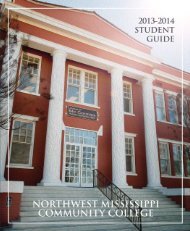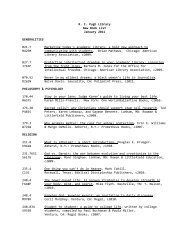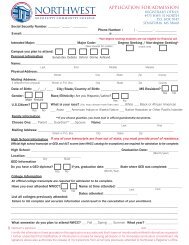Coping with Seven Disruptive Personality Types in the Classroom
Coping with Seven Disruptive Personality Types in the Classroom
Coping with Seven Disruptive Personality Types in the Classroom
Create successful ePaper yourself
Turn your PDF publications into a flip-book with our unique Google optimized e-Paper software.
want to keep that student <strong>in</strong> <strong>the</strong> class, ideally, but <strong>the</strong> student has to stop badger<strong>in</strong>g you andbehav<strong>in</strong>g <strong>in</strong> a hateful, attack<strong>in</strong>g manner, or <strong>the</strong> student will not make it through <strong>the</strong> course.Therefore, that relates to <strong>the</strong> whole issue of retention. You want to reta<strong>in</strong> that student, but <strong>the</strong>student has to desist behav<strong>in</strong>g that way, or he or she will not be able to stay <strong>in</strong> <strong>the</strong> class.In deal<strong>in</strong>g <strong>with</strong> sociopaths, it may be helpful to remember it is <strong>the</strong> personality makeup ofabout 3–5 percent of <strong>the</strong> population. It is a part of reality that you are not go<strong>in</strong>g to be able tochange.So <strong>the</strong> issue is not whe<strong>the</strong>r <strong>the</strong> person has that specific personality type; <strong>the</strong> issue is how <strong>the</strong>student behaves <strong>in</strong> your class. Certa<strong>in</strong>ly, many sociopaths have graduated from college andbeen successful <strong>in</strong> <strong>the</strong> bus<strong>in</strong>ess world and <strong>in</strong> politics, but <strong>the</strong>y probably managed not toengage <strong>in</strong> significant misconduct along <strong>the</strong> way. Or if <strong>the</strong>y did engage <strong>in</strong> misconduct, it wasei<strong>the</strong>r undetected or unproven.Some sociopathic students are apt to cheat or do o<strong>the</strong>r th<strong>in</strong>gs that are del<strong>in</strong>quent <strong>in</strong> <strong>the</strong>classroom or elsewhere that will draw negative attention and get <strong>the</strong>m <strong>in</strong>to trouble. Thesestudents have to be warned that <strong>the</strong>ir behavior is unacceptable and will have consequences.Warn<strong>in</strong>gs can aid <strong>in</strong> reta<strong>in</strong><strong>in</strong>g students, if it is possible. They must be warned that if <strong>the</strong>ycont<strong>in</strong>ue to engage <strong>in</strong> certa<strong>in</strong> behaviors, <strong>the</strong>y probably will not make it through <strong>the</strong> schoolexperience. Follow due process, and <strong>the</strong>n <strong>the</strong> student’s behavior will determ<strong>in</strong>e <strong>the</strong> outcome.It is truly <strong>in</strong> <strong>the</strong> <strong>in</strong>terest of students, whatever personality types <strong>the</strong>y exhibit, that <strong>the</strong>yreasonably conform to <strong>the</strong> Code of Student Conduct. That is <strong>the</strong> requirement. If you rem<strong>in</strong>dstudents about that, one way or <strong>the</strong> o<strong>the</strong>r <strong>the</strong>y will probably succeed and be reta<strong>in</strong>ed if <strong>the</strong>yare will<strong>in</strong>g to respect and conform to that particular non-negotiable requirement.Handl<strong>in</strong>g a student who responds <strong>with</strong> anger to firm <strong>in</strong>structions:The appropriate response to a student’s display of anger depends on <strong>the</strong> situation. As alreadymentioned, dimensions that affect <strong>the</strong> issue of free speech are th<strong>in</strong>gs like appropriate decibellevel or obscenities. Shout<strong>in</strong>g and curs<strong>in</strong>g are not permissible behaviors <strong>in</strong> a classroom. Theterm “anger” does not necessarily imply behavior that is unacceptable; it could, but it doesnot have to <strong>in</strong> itself.“Anger” connotes unacceptable behavior, but consider a student who responds angrily byshow<strong>in</strong>g displeasure. Perhaps he says someth<strong>in</strong>g <strong>in</strong> a civilized way, such as, “I don’t acceptyour po<strong>in</strong>t of view. I don’t like your decision about this. I don’t like your grade. I’m very angry<strong>with</strong> you.” There is probably noth<strong>in</strong>g an <strong>in</strong>structor has to do about that situation o<strong>the</strong>r than40


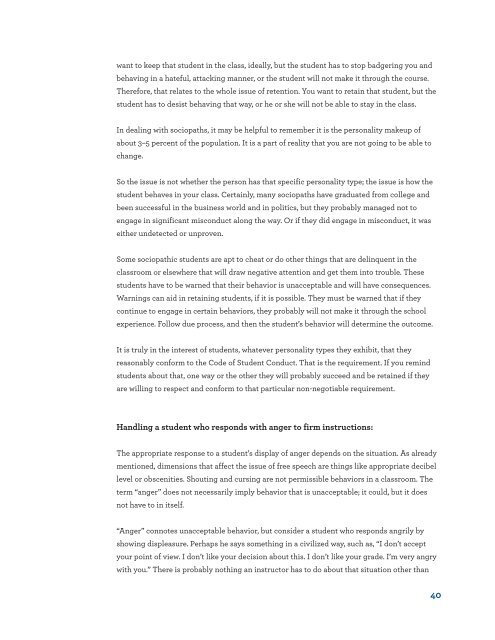

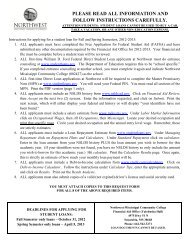






![Pro-Dental Hygiene [Major Code T34] - Northwest Mississippi ...](https://img.yumpu.com/35524032/1/190x149/pro-dental-hygiene-major-code-t34-northwest-mississippi-.jpg?quality=85)

